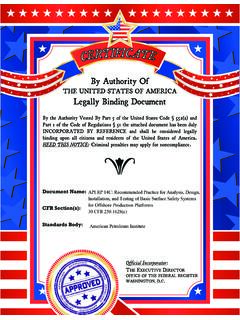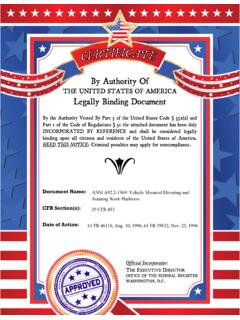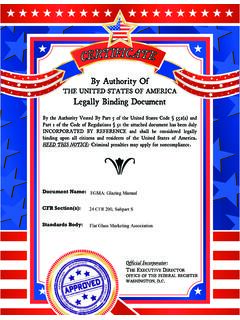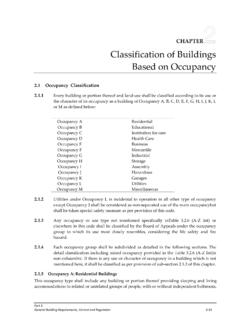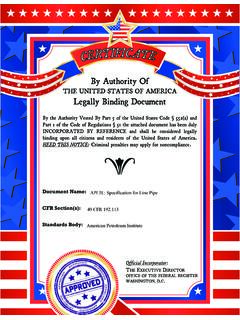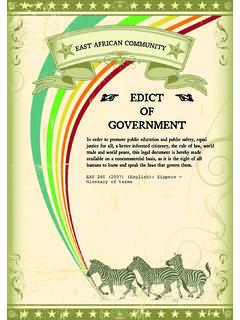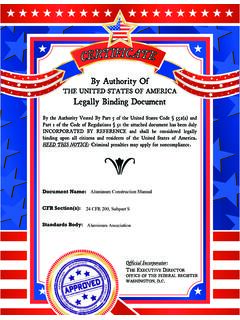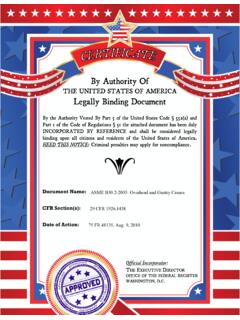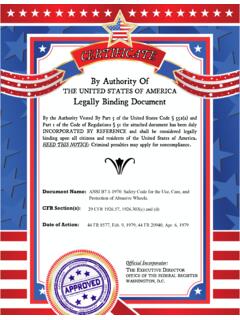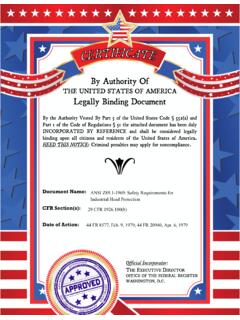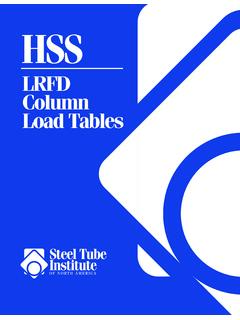Transcription of Glued laminated Beam desiGn taBles - Public.Resource.Org
1 Glued L aminated Beam desiGn taBles 2007 APA THE ENGINEERED WOOD ASSOCIATION ALL RIGHTS RESERVED. ANY COPYING, MODIFICATION, DISTRIBUTION OR OTHER USE OF THIS PUBLICATION OTHER THAN AS EXPRESSLY AUTHORIZED BY APA IS PROHIBITED BY THE COPYRIGHT LAWS. WOOD. The Natural Choice Engineered wood products are a good choice for the environment. They are manufactured for years of trouble-free, dependable use. They help reduce waste by decreasing disposal costs and product damage. Wood is a renewable, recyclable, biodegradable resource that is easily manufactured into a variety of viable products. A few facts about wood. We're growing more wood every day. Forests fully cover one-third of the United States' and one-half of Canada's land mass.
2 American landowners plant more than two billion trees every year. In addition, millions of trees seed naturally. The forest products industry, which comprises about 15 percent of forestland ownership, is responsible for 41 percent of replanted forest acreage. That works out to more than one billion trees a year, or about three million trees planted every day. This high rate of replanting accounts for the fact that each year, 27 percent more timber is grown than is harvested. Canada's replanting record shows a fourfold increase in the number of trees planted between 1975. and 1990. Life Cycle Assessment shows wood is the greenest building product. A 2004 Consortium for Research on Renewable Industrial Materials (CORRIM) study gave scientific validation to the strength of wood as a green building product.
3 In examining building products' life cycles from extraction of the raw material to demolition of the building at the end of its long lifespan CORRIM found that wood was better for the environment than steel or concrete in terms of embodied energy, global warming potential, air emissions, water emissions and solid waste production. For the complete details of the report, visit Manufacturing wood is energy efficient. Percent of Percent of Wood products made up 47 percent of all Material Production Energy Use industrial raw materials manufactured in the Wood 47 4. United States, yet consumed only 4 percent Steel 23 48. of the energy needed to manufacture all Aluminum 2 8. industrial raw materials, according to a 1987 study. Good news for a healthy planet.
4 For every ton of wood grown, a young forest produces tons of oxygen and absorbs tons of carbon dioxide. Wood: It's the natural choice for the environment, for desiGn and for strong, lasting construction. Glued laminated Beam desiGn taBles g CONTENTS. lued laminated beams (glulams) are used in a wide range of applications in both commercial table Pages and residential construction. The taBles in this Introduction 3. data file provide recom mended preliminary 24F Douglas-fir desiGn loads for two of the most common glulam Section Properties and Capacities 1 6. beam applications: roofs and floors. Simple Span taBles The recommendations in this publication apply to Roof Non-Snow Loads 2 7 8. Roof Snow Loads 3 9 10. glulam beams bearing the APA EWS trademark.
5 Floor 4 11 12. The mark appears only on beams manufactured Cantilever Span taBles by APA members and signifies that beams are Roof Non-Snow Loads 5 13. produced to the requirements of American National Roof Snow Loads 6 14. Standards Institute (ANSI) Standard This 24F Southern Pine is the national consensus standard recognized by Section Properties and Capacities 7 15. all model code agencies for the manufacture and Simple Span taBles trademarking of glulam. Roof Non-Snow Loads 8 16 17. Roof Snow Loads 9 18 19. The taBles included in this data file include Floor 10 20 21. values for section properties and capacities, and Cantilever Span taBles allowable loads for simple span and cantilevered Roof Non-Snow Loads 11 22. beams.
6 The taBles are based on an allowable Roof Snow Loads 12 23. bending stress of Fb = 2,400 psi for both Douglas- desiGn Examples 24 26. fir and southern pine. Volume Factors (Appendices) 27 30. These taBles assume the compression edge of the beam is braced to prevent lateral buckling. For other bracing conditions, the beams should be checked for lateral stability. For Douglas-fir, an allowable horizontal shear stress of Fv = 265 psi was used. For southern pine, an allowable horizontal shear stress of Fv = 300 psi was used. Glulam is also an excellent choice for vertical load carrying members ( , posts or columns). For information on the use of glulam for these applications, see APA publication, desiGn of Structural Glued laminated Timber Columns, Form Y240.
7 Section Properties and Capacities taBles 1 and 7 provide section properties and capacities for two commonly FIGURE 1. used species of glulam beams under dry-use conditions. Bending moment TYPICAL GLULAM. and shear capacities are based on a normal (10-year) duration of load . BEAM CROSS SECTION. Dimensions shown are net sizes, and capacities are based on loading per- y pendicular to the wide faces of the laminations; that is, bending about the x-x axis of the beam, as shown in Figure 1. Final desiGn should include a complete analysis, including bearing stresses and lateral stability. See desiGn Examples 1 and 4 (pages 24 and 26) for examples of preliminary desiGn using glulam beam section capacities from taBles 1 and 7. x x Allowable Loads for Simple Span Glulam Beams taBles 2, 3, 8 and 9 provide allowable loads for glulam beams used as simple span roof members in snow load areas (DOL factor = ) and for non-snow loads (DOL factor = ).
8 taBles 4 and 10 provide similar infor- mation for floor members. The taBles can be used to size such members for preliminary desiGn . Final desiGn should include a complete analysis, y including bearing stresses and lateral stability. See desiGn Examples 2 and 3 (pages 24-25) for examples of preliminary desiGn using glulam beam load -span taBles . Allowable Loads for Cantilevered Glulam Roof Beams taBles 5, 6, 11 and 12 are for preliminary desiGn of canti levered roof beams. The taBles are based on balanced (fully loaded) as well as unbalanced loading. They do not include deflection criteria limitations. Final designs should include deflection requirements per the applicable building code, in addition to the bending and shear strength assessments incorporated in these taBles .
9 Final desiGn should include a complete analysis, including bearing stresses and lateral stability. A minimum roof slope of 1/4 inch per foot in addition to specified camber is recommended to help avoid ponding of water on the roof. The cantilever beam taBles presented are applicable to balanced layups, such as 24F-V8 for Douglas-fir and 24F-V5 for southern pine, for three different systems. See Figure 2 for details of the following typical cantilever systems: System 1 is a two-equal-span cantilever system with the cantilevered beam extending past the center support by approximately times the span, or Its overall length is therefore , and the suspended beam's length is System 2 is a three-equal-span cantilever system with each of the two outer cantilevered beams extending past the center support into the middle span by Their length is therefore , and the interior suspended beam's length is System 3 is also a three-equal-span cantilever system, but the two outer span beams are suspended from the interior, double cantilevered beam, which extends past its two supports by approximately Its length is , and the suspended beams are each.
10 FIGURE 2. TYPICAL CANTILEVER BEAM SYSTEMS. SYSTEM 1. L L. SYSTEM 2. L L L. SYSTEM 3. L L L.. table 1. Douglas-fir Glued laminated Beam Section Properties and Capacities Fb = 2,400 psi, E = x 106 psi, F v = 265 psi 3-1/8-INCH WIDTH. 24F Douglas-fir Depth (in.) 6 7-1/2 9 10-1/2 12 13-1/2 15 16-1/2 18 19-1/2 21 22-1/2 24 25-1/2 27. Beam Weight (lb/ft) A ( ) S ( ) I ( ) 1170 1519 1931 2412 2966 3600 4318 5126. EI (106 ) 1153 1582 2106 2734 3476 4341 5339 6480 7773 9226. Moment Capacity (lb-ft) 3750 5859 8438 11480 15000 18980 23440 28360 33750 39610 45940 52730 60000 67730 75940. Shear Capacity (lb) 3313 4141 4969 5797 6625 7453 8281 9109 9938 10770 11590 12420 13250 14080 14910. 3-1/2-INCH WIDTH. Depth (in.) 6 7-1/2 9 10-1/2 12 13-1/2 15 16-1/2 18 19-1/2 21 22-1/2 24 25-1/2 27.
